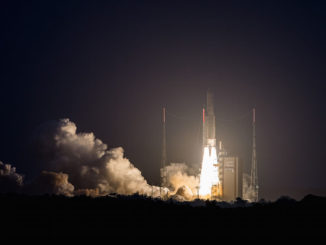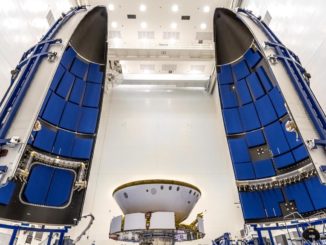A small spacecraft built for the Russian military lifted off Thursday on top of a modified Soyuz booster, beginning a mission to reportedly test a compact Earth-imaging platform that could be used on future spy satellites.
The lightweight payload rode a Soyuz 2-1v rocket into orbit from the Plesetsk Cosmodrome, a space base around 500 miles (800 kilometers) north of Moscow.
The Soyuz 2-1v rocket, a modified version of Russia’s venerable Soyuz rocket family, lifted off at 1738 GMT (1:38 p.m. EDT; 8:38 p.m. Moscow time) Thursday, according to a statement issued by the Russian Ministry of Defense.
Russian defense officials offered no description of the payload carried on the rocket, but the defense ministry said the launch proceeded in a “normal mode” and the spacecraft reached its planned orbit. The spacecraft was reported to be operating normally by the Russian Defense Ministry.
The satellite was named Kosmos 2525, keeping with the Russian military’s naming scheme for defense-related spacecraft.
Russian authorities did not officially announce the launch in advance, other than the release of standard warnings to pilots to keep out of drop zones north of Plesetsk, where pieces of the Soyuz rocket were expected to fall in the Barents Sea.
RussianSpaceWeb.com, run by the respected Russian space journalist Anatoly Zak, reported the Kosmos 2525 satellite launched Thursday is likely built on a new small satellite design capable of taking high-resolution surveillance imagery of Earth’s surface. Citing research by Bart Hendrickx, a Belgian expert on Russian space programs, Zak reported the circumstances of Thursday’s launch suggested it was related to a small satellite program known by the Russian acronym EMKA, which stands for Experimental Space Spacecraft.
Using miniaturized satellite and remote sensing technology, the EMKA satellite design could be the basis for a multi-spacecraft fleet of military-managed Earth-imaging missions. The demonstration spacecraft launched Thursday reportedly weighed less than 300 kilograms, or 660 pounds, at launch, but its exact dimensions and imaging capabilities were not confirmed.
U.S. military tracking data indicated the Kosmos 2525 satellite was circling Earth in a polar orbit an altitude of less than 200 miles, or about 315 kilometers, following Thursday’s launch.
Thursday’s launch was the fourth flight of Russia’s Soyuz 2-1v booster, which uses a single liquid-fueled NK-33 first stage engine originally developed for the Soviet-era N1 moon rocket. The Soyuz 2-1v replaces the Soyuz rocket’s four-nozzle core stage engine with a single-nozzle NK-33, and designers removed the four strap-on boosters that normally fly on Soyuz missions.
Four vernier steering engines are also mounted around the NK-33 engine on the Soyuz 2-1v first stage. The modified launcher’s second stage is powered by an RD-0124 engine, the same type of powerplant also used on the modernized Soyuz 2-1b version of Russia’s classic Soyuz rocket.
Russian engineers kept the NK-33 engines in storage after the N1 moon rocket was canceled. Some of the NK-33 engines were exported to the United States, where they were upgraded to fly on Orbital ATK’s Antares rocket to launch supplies to the International Space Station.
One of the modified NK-33 engines — known as an AJ26 in the United States — failed shortly after an Antares launch in 2014, prompting Orbital ATK to switch to a new engine type. But NK-33 engines have flown on the Soyuz 2-1v rocket four times, all successfully.
Engineers designed an upgraded combustion chamber and a new igniter chamber for installation on the leftover NK-33 engines to fly on future Soyuz 2-1v rockets, which are sized to haul smaller payloads into space than conventional Soyuz launchers.
One of the four Soyuz 2-1v flights failed to release a satellite into orbit in 2015, but that failure was not related to the NK-33 engine.
Email the author.
Follow Stephen Clark on Twitter: @StephenClark1.



